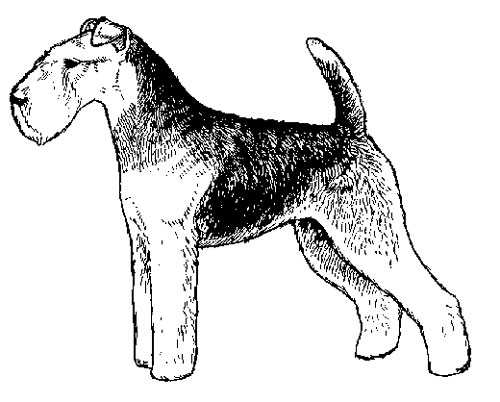Welsh Terrier
Terrier Group
The goals and purposes of this breed standard include: to furnish guidelines for breeders who wish to maintain the quality of their breed and to improve it; to advance this breed to a state of similarity throughout the world; and to act as a guide for judges.
Breeders and judges have the responsibility to avoid any conditions or exaggerations that are detrimental to the health, welfare, essence and soundness of this breed, and must take the responsibility to see that these are not perpetuated.
Any departure from the following should be considered a fault, and the seriousness with which the fault should be regarded should be in exact proportion to its degree and its effect upon the health and welfare of the dog and on the dog’s ability to perform its traditional work.
History
Descended from the Old English Black and Tan (Broken Coated) Terrier, this breed was developed in Wales to hunt badger, fox and otter. It is most likely the most direct descendant in existence today of that earlier breed and has been documented as far back as the early 1700s.
The Welsh Terrier was recognized by the United Kennel Club in 1936.
General Appearance
The sturdy, compact Welsh Terrier conveys the image of a square dog, being approximately as high as he is long. He is a medium-sized, rugged dog, with a coarse, wire-textured coat.
Characteristics
The breed is friendly and outgoing with people and other dogs. It shows spirit and courage, always being alert and aware while showing self-control. Intelligence and the desire to please are evident. The characteristic "Welsh Terrier expression" is shown in the set, color and position of the eyes, combined with the use of the ears.
Head
The head is rectangular in shape. The top lines of the skull and muzzle are parallel and are joined by a slight stop.
SKULL
Moderately wide and flat between the ears, without wrinkle.
MUZZLE
Approximately the same length as the skull, with deep, strong jaws, flat cheeks and tight, black lips.
TEETH
A full complement of large, strong, white teeth meet in a scissors bite.
EYES
Small, dark and deeply set, giving the steady, confident, alert expression typical of the Welsh Terrier. NOSE Black in color, squared-off in shape.
EARS
Small and V-shaped, not too thin. The ears fold just above the topline of the skull and are carried forward close to the cheek.
Neck
The slightly arched neck is of moderate length and thickness and slopes gracefully into the shoulders. The clean throat has no excess skin.
Forequarters
The long, sloping shoulders are well laid back.
FORELEGS
The forelegs are straight and muscular with good bone. Pasterns are strong and upright.
Body
The body has good substance. It is well ribbed up and has a level topline. The moderately short loin is strong. The brisket has good depth, and the chest is of moderate width.
Hindquarters
The strong, muscular hindquarters have well-developed thighs of good length.
HIND LEGS
Well bent at the stifle and hock, with short, strong rear pasterns.
Feet
The small, round, cat-like feet have thick, black pads and strong, black nails.
Tail
Set on high and carried erect, the tail is customarily docked to a length that completes the look of a square outline. If undocked, not curved over the back.
Coat
The hard, wiry, dense outer coat has a close fitting jacket. The undercoat is short and soft. Dense, wiry furnishings are found on the muzzle, legs and quarters.
The furnishings on the foreface are trimmed to complete (without exaggeration) the total rectangular outline of the head.
Color
The black jacket spreads up onto the neck, down onto the tail and into the upper thighs. The legs, quarters and head are a clear tan, which is a deep reddish brown with slightly lighter shades acceptable. A black grizzle jacket is also acceptable.
Serious Fault: Black below the hocks.
Height & Weight
Males are approximately 15 inches at the withers, with an acceptable range between 15 and 15½ inches. Bitches are proportionately smaller.
The average weight is approximately twenty pounds.
Gait
Straight, free and effortless, with good reach and strong drive. Front and rear legs move parallel with stifles turning neither in nor out.
Disqualifications
(A dog with a Disqualification must not be considered for placement in a conformation event, and must be reported to UKC.)
Unilateral or bilateral cryptorchid.
Viciousness or extreme shyness.
Albinism.
The docking of tails and cropping of ears in America is legal and remains a personal choice. However, as an international registry, the United Kennel Club is aware that the practices of cropping and docking have been forbidden in some countries. In light of these developments, the United Kennel Club feels that no dog in any UKC event, including conformation, shall be penalized for a full tail or natural ears.

Looking for a Dog?
Find a dog that will fit your family.
Note: The breeders on this list are not endorsed by UKC.
Revised April 2007
©Copyright 1992, United Kennel Club
